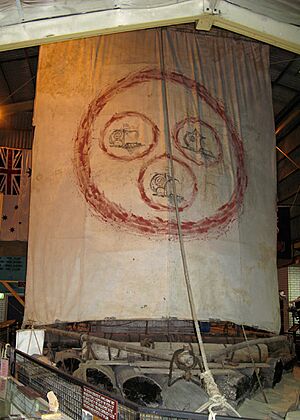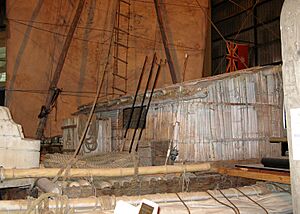Vital Alsar Pacific raft expeditions facts for kids

Imagine sailing across the huge Pacific Ocean on a simple raft! Between 1966 and 1973, a brave Spanish explorer named Vital Alsar led three amazing trips to do just that. He wanted to cross the Pacific from Ecuador, South America, all the way to Australia.
His first trip, called La Pacífica in 1966, didn't quite make it. But his next two trips, La Balsa in 1970 and Las Balsas in 1973, were a huge success! They even set new records for the longest raft journeys ever known. La Balsa traveled about 13,800 kilometers (8,600 miles), and Las Balsas went even further, about 14,500 kilometers (9,000 miles). These voyages showed how ancient sailors might have traveled long distances.
Contents
Why Sail on a Raft?
Vital Alsar's main goal was to prove something very interesting. He believed that the Pacific Islands could have been settled by people traveling from South America many centuries ago. This would have happened long before Spanish explorers arrived. Alsar thought that ancient sailors knew the ocean's currents and winds just as well as we know our roads today.
His expeditions were inspired by the famous Kon-Tiki expedition of 1947. That trip, led by Thor Heyerdahl, also used a raft to travel from South America to the Polynesian islands. Alsar wanted to go even further! He also wanted to show that rafts made from materials available in the 16th century, like those seen by early Spanish sailors, could really make such a long journey.
After the success of the La Balsa trip, Alsar wanted to do something even bigger. He planned a third voyage, but this time with three rafts! This was to show that early civilizations could have traveled in large groups, carrying cargo, using many rafts together. The Las Balsas trip also aimed to prove that the success of La Balsa wasn't just luck.
How They Got Money
To help pay for the Las Balsas expedition, Vital Alsar had his future crew build small models of the rafts. They showed these models to people who might want to help fund the trip. Even the famous artist Salvador Dalí helped out! He donated an original artwork for the sails. Selling this artwork later helped the crew pay off debts and get home.
La Pacífica: The First Try
Vital Alsar's first big adventure was in 1966. The day after he got married, he set off on a simple raft called La Pacífica. He planned to sail from Ecuador to Australia. However, this journey ended early after 143 days. Tiny worms, called teredo worms, attacked the wood of his raft. The raft began to sink, but luckily, a German ship rescued the crew.
La Balsa: A Record-Breaking Journey
The second raft was named La Balsa, which means "The Raft" in Spanish. It was built from balsa wood logs tied together with strong hemp ropes. It had two wooden masts that held a large square canvas sail. Unlike the Kon-Tiki raft, which used an oar to steer, La Balsa had special moving wooden boards called "Guaras." These allowed the crew to steer the raft towards helpful ocean currents, rather than just drifting.
The journey started in Guayaquil, Ecuador. Alsar gathered a small crew: Marc Modena from France, Norman Tetreault from Canada, and Gabriel Salas, a student from Chile. They even had a stowaway cat named Minet, who they called their "fifth crew member"!
The La Balsa expedition lasted 160 days. It began on May 29, 1970, and finished in Mooloolaba, Australia, on November 5, 1970. This incredible 13,800-kilometer (8,600-mile) voyage was the longest raft journey known at that time.
After the trip, the raft was taken on a tour around Australia, visiting cities like Brisbane and Sydney. Later, it was shipped to Spain.
Las Balsas: Three Rafts, One Ocean
The 1973 Las Balsas expedition was even more ambitious. It used three rafts and became the longest-known raft voyage in history. It's also the only time anyone has crossed the Pacific Ocean with multiple rafts at once!
Who Sailed?
This expedition had three rafts, twelve sailors, and three cats – one cat for each raft!
Vital Alsar had specific requirements for his crew. They needed to know how to navigate and speak at least three languages.
The crew came from many different countries:
- Vital Alsar, from Spain, was the leader and captain of the Guayaquil raft.
- Marc Modena, from France, was captain of the Mooloolaba raft.
- Jorge Ramírez, from Mexico, was captain of the Aztlán raft.
- Fernand Robichaud, from Canada.
- Greg Holden, from Canada.
- Gaston Colin, from Canada.
- Tom McCormick, from the United States.
- Tom Ward, from the United States.
- Mike Fitzgibbons, from the United States.
- Hugo Becerra, from Chile.
- Gabriel Salas, from Chile (who had also been on the La Balsa trip).
- Aníbal Guevara, from Ecuador.
The Rafts
The three rafts were named "Guayaquil" (after their starting point), "Mooloolaba" (after their planned arrival in Australia), and "Aztlán" (after Mexico, where the trip was organized). These rafts were built just like the ones used by South American natives centuries ago.
Each raft was about 14 meters (46 feet) long and 5.5 meters (18 feet) wide. They were made from seven large balsa wood logs. These logs were cut from special trees in Ecuador during a full Moon to make them stronger against seawater. The logs were then floated down a river to a naval base in Guayaquil for construction. The rafts were built entirely from wood, using wooden pegs and sisal ropes. No metal parts like nails or cables were used!
The rafts were very stable on the water and didn't rock much, even in rough seas. They couldn't turn around easily when carried by currents. However, they could steer using special short planks between the logs, called "guayas" or centerboards.
They carried enough fresh water for a few weeks. After that, they relied on collecting rainwater in buckets. A daily chore was cleaning seaweed and slime off the logs. The rafts were stocked with rice, beans, and some canned food. But their main food source was fresh seafood caught along the way, like tuna and mahi-mahi. Fish were plentiful around the rafts, as barnacles growing on the rafts attracted smaller fish, creating a mini food chain. The crew even had to kill sharks twice because they were scaring away other fish.
Each raft had a short-range radio for emergencies and to contact land every three days.
The Long Journey
On May 27, 1973, the three rafts set sail from Guayaquil, Ecuador. They drifted across the Pacific Ocean, passing by the Galapagos Islands, the Society Islands, The Cook Islands, and Tonga. Near Tonga, they faced a very strong storm that lasted for eight days!
As they got close to the Australian coast near Mooloolaba, Queensland, they accepted help from an Australian Navy ship, HMAS Labuan, to tow them to shore. But another storm hit! About eight kilometers (five miles) from shore, for safety, the crew of the Guayaquil raft was taken aboard the Navy ship, and their raft was released. The other two rafts were then safely brought to land in Ballina, New South Wales.
The expedition arrived in Ballina on November 21, 1973. After traveling 14,500 kilometers (9,000 miles) and spending 179 days at sea, the crews received a hero's welcome from the people of Ballina. Amazingly, all three rafts had managed to stay in sight of each other for most of the trip. One raft got separated in a storm, but after a week, they found each other again using radio communication.
The Guayaquil raft, which had been released, was later found by fishermen near Newcastle. Sadly, it was eventually burned for scrap.
In the News
A documentary film called The Pacific Challenge was made about the expedition. You can find it at the Ballina Maritime Museum. The Las Balsas journey was also featured in an 11-minute radio documentary by the BBC in 2014, with interviews from crew members Mike Fitzgibbons and Gabriel Salas.
Museum and Surviving Raft
After the journey, the Mooloolaba and Aztlán rafts were moored in the Richmond River. However, the hemp ropes started to break down, and the rafts began to fall apart. When crew members and supporters returned to re-tie them, they found that Mooloolaba had mostly disintegrated, with its mast, sail, and many logs floating away. The Aztlán was saved and moved to dry land a few months later by the Ballina Shire Council.
A few years later, the Council built a museum next to their Information Centre. Inside, they created a display raft using the best parts of the two remaining rafts. This museum also has items dedicated to the famous aviator Sir Charles Kingsford Smith. Thousands of visitors each year come to see this amazing exhibition and learn about the incredible journey of these twelve men.
What They Left Behind
After the initial excitement, the voyages were largely forgotten by many, even though some in the media compared them to the achievements of pioneers like Charles Lindbergh and Edmund Hillary. The crew members have expressed some sadness about this. They thought that if their raft had ended up in a big city museum, like the Kon-Tiki raft in Oslo, more people might remember it. However, they also didn't want the surviving raft to be moved from where it landed. The museum curator agrees, but also thinks it's partly because Australians tend to be modest about their achievements.
In November 2013, a 40th-anniversary celebration was held at the museum. Some of the crew members reunited there for the first time since their epic voyage.
See also
- Pre-Columbian trans-oceanic contact
- Pre-Columbian rafts
- William Willis (traveller) – another person who rafted across oceans alone.
- Tim Severin


